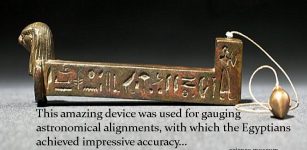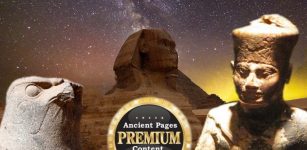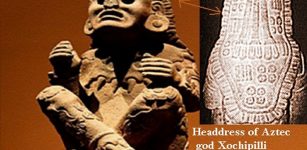Vikings And The Runic Calendar
AncientPages.com - The Vikings used a Runic calendar often written on parchment or carved onto staves of wood, bone, or horn. The year was divided into moon phases and the calendar reflected the seasons.
Sometimes, during summer it was difficult to observe the Moon because nights are so bright in Scandinavia that it is almost impossible to spot the Moon, especially in the northern parts.
Detail of a Runic Calendar, showing the three rows of symbols. Based on page 104 of F.E. Farwerck's Noord-Europese Mysteriën. Image credit: Wikipedia
The Vikings also observed how high the sun was in the sky because like all people they depended on weather for their survival. The year was divided into two equally long periods – summer and winter. A person’s age was counted in the number of winters he had lived.
The oldest discovered Runic calendar is the Nyköping staff from Sweden. Archaeologists and historians, think it is from the 13th century. Most Runic calendars are from the 16th and the 17th centuries.
Worm’s Norwegian runic calendar described in his book Fasti Danici dating back to 1643.
The drawing only shows the winter season lasting from 14 October to 13 April. The summer season on the other side of the bone from a whale or big fish was never copied, and both the pendant and the calendar have unfortunately been lost.
A typical Runic calendar consisted of several horizontal lines of symbols, one above the other. Special days like solstices, equinoxes, and celebrations were marked with additional lines of symbols. The Norse calendar system was also created using the Younger Futhark alphabet combined with three additional symbols, giving every day of the year a corresponding rune or combination of runes.
See also:
Runes: Facts And History About Odin’s Secret Language
Unravelling The Mystery Of The Ulfberht Sword – An Ancient Viking Artifact Far Ahead Of Its Time
The darkest period was named “Skammdegí” (the Dark Days) and the year’s brightest period “Nóttleysa”, meaning “insomnia” that many Scandinavians still experience today.
The winter months are Gormánuður, Ýlir, Mörsugur, Þorri, Goa and Einmánuður.
The summer months are Harpa, Skerpla, Sólmánuður, Heyannir, Tvímánuður and Haustmánuður.
Some years it may look as if it has been an additional 13th month to adjust the calendar: Silðemanuður (the Late Month).
The Runic calendar is a perpetual calendar which means it was designed to be valid for many years and allow the calculation of the day of the week for a given date in the future.
Copyright © AncientPages.com All rights reserved. This material may not be published, broadcast, rewritten or redistributed in whole or part without the express written permission of AncientPages.com
Expand for referencesReferences:
Thor News – The Viking Calendar
More From Ancient Pages
-
 Merkhet – An Ancient Egyptian Timekeeping Instrument
Ancient History Facts | Jul 3, 2018
Merkhet – An Ancient Egyptian Timekeeping Instrument
Ancient History Facts | Jul 3, 2018 -
 Uplistsikhe Devastated By Genghis-Khan Hordes But Once City-Fortress Of Queen Tamar
Featured Stories | Apr 12, 2021
Uplistsikhe Devastated By Genghis-Khan Hordes But Once City-Fortress Of Queen Tamar
Featured Stories | Apr 12, 2021 -
 Jigai – Suicide Ritual For Wives Of Samurai – Feminine Counterpart Of Seppuku
Ancient History Facts | Feb 24, 2018
Jigai – Suicide Ritual For Wives Of Samurai – Feminine Counterpart Of Seppuku
Ancient History Facts | Feb 24, 2018 -
 Heyoka – Sacred Clown Who By Doing The Opposite Helps And Guides In Daily Life
Native American Mythology | Feb 7, 2019
Heyoka – Sacred Clown Who By Doing The Opposite Helps And Guides In Daily Life
Native American Mythology | Feb 7, 2019 -
 Pan Twardowski – The Man Who Sold His Soul To The Devil In Exchange For Special Powers
Featured Stories | Aug 12, 2021
Pan Twardowski – The Man Who Sold His Soul To The Devil In Exchange For Special Powers
Featured Stories | Aug 12, 2021 -
 Rare 2000-Year-Old Celtic Figurine Among Finds In Cambridgeshire
Archaeology | Dec 18, 2018
Rare 2000-Year-Old Celtic Figurine Among Finds In Cambridgeshire
Archaeology | Dec 18, 2018 -
 Powerful Winds In Ancient Beliefs
Featured Stories | Feb 5, 2024
Powerful Winds In Ancient Beliefs
Featured Stories | Feb 5, 2024 -
 Unique Ancient Man-Made Underground Structure In New England Puzzles Experts – Who Built It And Why?
Featured Stories | Aug 11, 2024
Unique Ancient Man-Made Underground Structure In New England Puzzles Experts – Who Built It And Why?
Featured Stories | Aug 11, 2024 -
 The Untold Story Of The Great Sphinx – One Of The Greatest – Part 1
Ancient Mysteries | Aug 9, 2019
The Untold Story Of The Great Sphinx – One Of The Greatest – Part 1
Ancient Mysteries | Aug 9, 2019 -
 Incredible Treasure Discovered In The Secret Chamber Of The Great Pyramid 1,200 Years Ago May Offer Proof Of Long-Lost Scientific Knowledge
Ancient Mysteries | Dec 31, 2018
Incredible Treasure Discovered In The Secret Chamber Of The Great Pyramid 1,200 Years Ago May Offer Proof Of Long-Lost Scientific Knowledge
Ancient Mysteries | Dec 31, 2018 -
 Templo Mayor – Sacred Aztec Complex Dedicated To Gods Tlaloc And Huitzilopochtli Who Were Usually Appeased With Human Sacrifices
Featured Stories | Jan 23, 2018
Templo Mayor – Sacred Aztec Complex Dedicated To Gods Tlaloc And Huitzilopochtli Who Were Usually Appeased With Human Sacrifices
Featured Stories | Jan 23, 2018 -
 Stones Of Rajajil – Sophisticated Road Markers Or An Ancient Astronomical Observatory?
Civilizations | May 21, 2017
Stones Of Rajajil – Sophisticated Road Markers Or An Ancient Astronomical Observatory?
Civilizations | May 21, 2017 -
 Nue – Mysterious Mythological Shape-Shifting Creature Transforming Into A Black Cloud
Featured Stories | Jun 12, 2020
Nue – Mysterious Mythological Shape-Shifting Creature Transforming Into A Black Cloud
Featured Stories | Jun 12, 2020 -
 Exploring Future Evolution: How Will Humans Change In The Next 10,000 Years?
Featured Stories | Oct 3, 2022
Exploring Future Evolution: How Will Humans Change In The Next 10,000 Years?
Featured Stories | Oct 3, 2022 -
 Old Royal Crime – Dark Riddle Of Young Princes In The Tower Of London
Featured Stories | Jun 14, 2020
Old Royal Crime – Dark Riddle Of Young Princes In The Tower Of London
Featured Stories | Jun 14, 2020 -
 Is A Viking Ship Hidden In The Colorado Desert?
Featured Stories | Jan 8, 2018
Is A Viking Ship Hidden In The Colorado Desert?
Featured Stories | Jan 8, 2018 -
 Traces Of The Watchers In Ancient China Shed New Light On This Mysterious Lost Race
Ancient Mysteries | Aug 11, 2018
Traces Of The Watchers In Ancient China Shed New Light On This Mysterious Lost Race
Ancient Mysteries | Aug 11, 2018 -
 Xibalba: Nine-Leveled Underground Place Of Fear Ruled By Lords Of Death In Maya Beliefs
Featured Stories | May 12, 2020
Xibalba: Nine-Leveled Underground Place Of Fear Ruled By Lords Of Death In Maya Beliefs
Featured Stories | May 12, 2020 -
 Xochipilli: Aztec God Of Love, Music, Song And Ecstatic Mushroom Trance
Aztec Mythology | May 19, 2018
Xochipilli: Aztec God Of Love, Music, Song And Ecstatic Mushroom Trance
Aztec Mythology | May 19, 2018 -
 Wars Of The Roses: Thirty Two Years Of Struggle To Claim English Throne
Featured Stories | Aug 5, 2017
Wars Of The Roses: Thirty Two Years Of Struggle To Claim English Throne
Featured Stories | Aug 5, 2017




